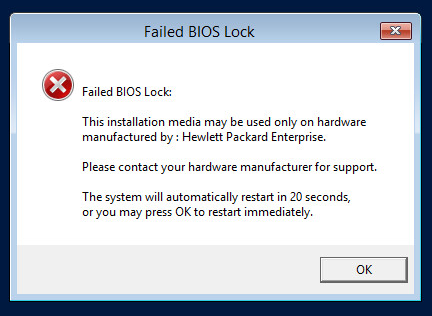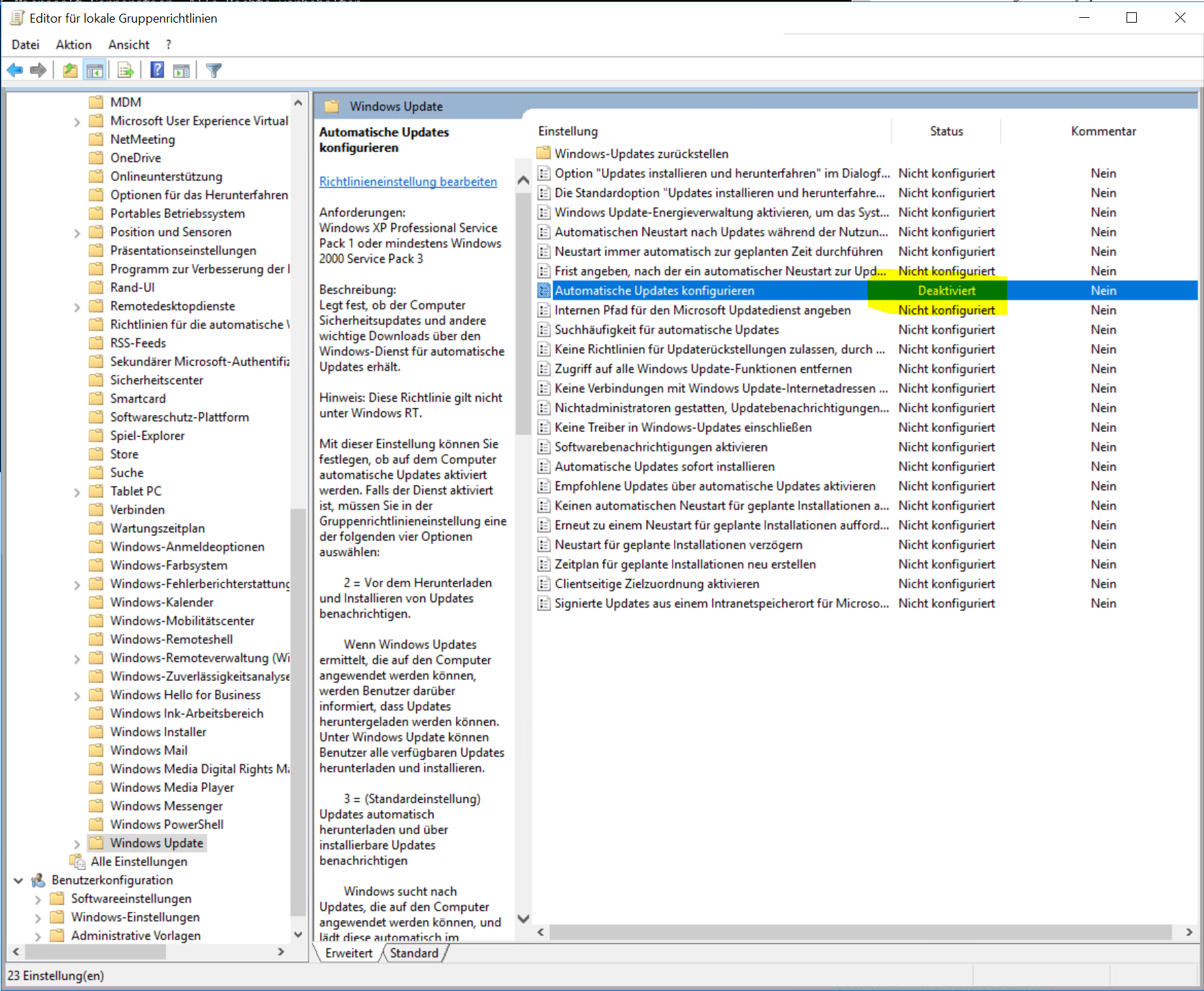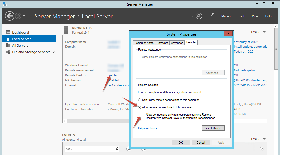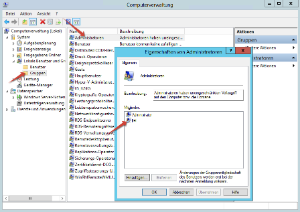Versions Windows supportées| Version | Soutient | Recommandation |
|---|
| Windows Server 2008 | Non |
| | Windows Server 2008 R2 | Oui | Ne pas utiliser pour de nouvelles installations.
Programmer la mise à jour vers la nouvelle version. | | Windows Server 2012 | Non |
| | Windows Server 2012 R2 | Oui | Ne pas utiliser pour de nouvelles installations.
Programmer la mise à jour vers la nouvelle version. | | Windows Server 2016 | Non |
| | Windows Server 2016 R2 | Oui |
| | Windows Server 2019 | Oui |
|
NotePour installer les pilotes SIP sous Windows Server 2016 R2 et Windows Server 2019, il faut désactiver le Secure Boot. Consultez la documentation de votre environnement virtuel pour savoir comment procéder. Suppression du verrouillage du BIOS sur les versions OEM de Windows ServerParfois, lors de l'installation dans VMWare en utilisant une image provenant d'une version OEM de Windows Server, une erreur peut se produire, comme celle-ci :  Image Added Image Added
Pour y remédier, procédez comme suit: | Translations Ignore |
|---|
| Code Block |
|---|
Lorsque le client VSphere est installé, naviguez vers la VM et modifiez les paramètres. Dans l'onglet "Options", naviguez jusqu'à "Avancé" et cliquez sur "Général". Configurer les paramètres sur la droite et ajouter une nouvelle ligne aux paramètres appelée "smbios.ReflectHost" avec une valeur de "true". Faites-le avec la VM éteinte, si elle est allumée, redémarrez la VM. Le verrou est levé. |
|
Serveur proxyCertaines applications (telles que GIT) nécessitent la spécification explicite d'un proxy. Ceci peut être déterminé avec la commande suivante si les réglages sont automatiques | Translations Ignore |
|---|
| Code Block |
|---|
netsh winhttp show proxy |
|
Installation de base du système d'exploitation Windows Server est installé à partir d'un DVD d'installation ou d'un fichier ISO sans aucune précaution ou ajustement particulier. Attention : la version AVEC interface utilisateur graphique doit être installée. Au cours de l'installation, le système est redémarré plusieurs fois. Une fois l'installation terminée, le système demande généralement un mot de passe pour l'utilisateur de l'administrateur local. Si cette option est activée, vous êtes dans le bureau normal. Comme la routine d'installation ne permet pas de réglages importants, plusieurs caractéristiques communes ont déjà été définies automatiquement : - Nom d'hôte : Un nom d'hôte a été généré automatiquement.
- Configuration du réseau : Le programme d'installation de Windows configure automatiquement les cartes réseau trouvées avec le DHCP. Si un serveur DHCP est disponible, le Windows installé peut être atteint sous une adresse attribuée dynamiquement. Si une telle adresse n'est pas disponible, l'adaptateur réseau doit être configuré de manière à pouvoir fonctionner sous une adresse connue sur le réseau.
Mises à jour Windows- Veuillez continuer à mettre à jour Windows jusqu'à ce que vous ne trouviez plus de mises à jour.
- Si cela doit être fait par le technicien du projet, cela représente un travail supplémentaire.
- Ensuite, les mises à jour automatiques de Windows doivent être désactivées.
- Sur Windows Server 2012 R2, le paramètre est disponible via "Mises à jour Windows" et peut être facilement cliqué.
- Sous Windows Server 2016, cette option est plus cachée.
Appuyez sur Windows + R et entrez gpedit.msc.
Ensuite, naviguez jusqu'à la branche suivante :
Configuration de l'ordinateur ... Modèles administratifs ... Composants de Windows ... Windows Update. Ici, désactivez l'option en conséquence.
 Image Added Image Added
Conditions requises pour la remise au technicien du projetLes réglages suivants doivent maintenant être effectués sur la machine Windows: - Définissez le nom d'hôte du système.
- Définissez l'adresse IP, le masque de réseau, la passerelle par défaut et le serveur DNS. L'adresse doit être statique ou une réservation dans le DHCP doit être disponible.
- Si le client le souhaite, ajouter des ordinateurs au domaine (nécessite un compte de domaine dûment autorisé et un redémarrage) Doit être fait en coopération avec l'administrateur du client si nécessaire.
- Activer le bureau à distance. Cela peut être fait via le gestionnaire de serveur:
 Image Added Image Added - Créez un utilisateur JTEL local et ajoutez-le au groupe d'administrateurs locaux. Cela peut se faire via l'administration informatique :
 Image Added Image Added
ATTENTION: Si le client insiste pour que les programmes jtel soient exécutés sous un compte de domaine parce que, par exemple, les politiques de l'entreprise ou du domaine n'autorisent pas les utilisateurs locaux de Windows, ce compte doit se voir attribuer des droits d'administrateur sur ce serveur spécifique. Il doit donc être inclus dans le groupe administrateur local. Dans le domaine, ce compte n'a pas besoin de droits supplémentaires. - Pour les machines virtuelles : L'installation des outils pour les invités (c'est-à-dire VMware Tools, Hyper-V Integration Services, etc.)
- Installer toutes les mises à jour de Windows
TestsAprès un redémarrage, il faut maintenant vérifier ce qui suit: - Le système est accessible via RDP.
- Il est possible pour le technicien du projet de se connecter au système en tant qu'utilisateur jtel via un client de bureau à distance.
- Le technicien du projet peut lancer un processus en tant qu'administrateur dans une telle session.
Si le client installe les systèmes d'exploitation, c'est généralement le point de transfert au technicien du projet. Adaptation du système d'exploitationLes réglages supplémentaires suivants sont maintenant effectués sur la machine Windows par le technicien du projet: - Java
- https://cdn.jtel.de/downloads/java/jdk-8u202-windows-x64.exe
- Bibliothèques des compilateurs
- https://cdn.jtel.de/downloads/redist/vcredist_9.0_x86_9.0.30729.4148.exe
- https://cdn.jtel.de/downloads/redist/vcredist_2010_x86_10.0.30319.exe
- https://cdn.jtel.de/downloads/redist/vcredist_2012_x64_11.0.61030.exe
- https://cdn.jtel.de/downloads/redist/vcredist_2012_x86_11.0.61030.exe
- https://cdn.jtel.de/downloads/redist/vcredist_2015_x64_14.0.24123.exe
- https://cdn.jtel.de/downloads/redist/vcredist_2015_x86_14.0.24123.exe
- https://cdn.jtel.de/downloads/redist/vcredist_2017_x64_14.16.27027.exe
- https://cdn.jtel.de/downloads/redist/vcredist_2017_x86_14.16.27027.exe
- https://cdn.jtel.de/downloads/redist/ww_icl_redist_ia32_2017.1.143.msi
- https://cdn.jtel.de/downloads/redist/ww_icl_redist_intel64_2017.1.143.msi
- Environnement Cygwin. L'installation se fait en plusieurs étapes:
- https://www.cygwin.com/setup-x86_64.exe
- "Installer à partir d'Internet"
- Répertoire Cible : C:\Cygwin
- Répertoire des paquets:
C:\Cygwin\packages - Sélectionner les paquets:
openssh (Zone "Net")
ncftp (Zone "Net")
curl (Zone "Net")
wget (Zone "Web")
- Git Pre-Requisites:
- https://cdn.jtel.de/downloads/tools/Git-2.16.2-64-bit.exe
IMPORTANT : N'installez pas le Git Credential Manager
- GIT Client:
- https://cdn.jtel.de/downloads/tools/TortoiseGit-2.6.0.0-64bit.msi
Nom: jtel Support
email: support@jtel.de
- Editeur de texte Notepad++
https://cdn.jtel.de/downloads/tools/npp.7.5.6.Installer.exe
- Connecteur ODBC MySQL:
NOTE : En raison de problèmes de mémoire dans les pilotes MySQL les plus récents, il est recommandé de travailler avec la version 5.2.7 Même dans les derniers pilotes ODBC 8.x, des problèmes de mémoire se produisent lorsque les connexions à la base de données échouent.
- https://cdn.jtel.de/downloads/tools/mysql-connector-odbc-5.2.7-win32.msi
- Google Chrome:
- (Anglais) https://www.google.com/chrome/browser/desktop/index.html?system=true&standalone=1&platform=win64&hl=en
- (Allemand) https://www.google.com/chrome/browser/desktop/index.html?system=true&standalone=1&platform=win64&hl=de
- Paramètres de l'explorateur Windows:
- démarrer l'explorateur (Win+E)
- "Voir" ... "Options"
- activer "Afficher tous les dossiers"
- activer les "extensions de noms de fichiers"
- Paramètres CMD:
- a choisi "Défauts"
- désactiver le "Mode d'édition rapide » Ceci doit être fait de manière à ce que les services fonctionnant en mode cmd ne soient pas interrompus par un clic de souris.
- "Mise en page" fixe les deux valeurs de "largeur" à 125
- "Mise en page" fixe la valeur de la "Hauteur" dans la zone "Taille de la fenêtre" à 50
Tous les téléchargements| Translations Ignore |
|---|
| Code Block |
|---|
| title | Tous les téléchargements |
|---|
| https://cdn.jtel.de/downloads/java/jdk-8u202-windows-x64.exe https://cdn.jtel.de/downloads/redist/vcredist_9.0_x86_9.0.30729.4148.exe https://cdn.jtel.de/downloads/redist/vcredist_2010_x86_10.0.30319.exe https://cdn.jtel.de/downloads/redist/vcredist_2012_x64_11.0.61030.exe https://cdn.jtel.de/downloads/redist/vcredist_2012_x86_11.0.61030.exe https://cdn.jtel.de/downloads/redist/vcredist_2015_x64_14.0.24123.exe https://cdn.jtel.de/downloads/redist/vcredist_2015_x86_14.0.24123.exe https://cdn.jtel.de/downloads/redist/vcredist_2017_x64_14.16.27027.exe https://cdn.jtel.de/downloads/redist/vcredist_2017_x86_14.16.27027.exe https://cdn.jtel.de/downloads/redist/ww_icl_redist_ia32_2017.1.143.msi https://cdn.jtel.de/downloads/redist/ww_icl_redist_intel64_2017.1.143.msi https://www.cygwin.com/setup-x86_64.exe https://cdn.jtel.de/downloads/tools/Git-2.16.2-64-bit.exe https://cdn.jtel.de/downloads/tools/TortoiseGit-2.6.0.0-64bit.msi https://cdn.jtel.de/downloads/tools/npp.7.5.6.Installer.exe https://cdn.jtel.de/downloads/tools/mysql-connector-odbc-5.2.7-win32.msi (Englisch) https://www.google.com/chrome/browser/desktop/index.html?system=true&standalone=1&platform=win64&hl=en (Deutsch) https://www.google.com/chrome/browser/desktop/index.html?system=true&standalone=1&platform=win64&hl=de |
|
Si Chrome est installé et défini comme votre navigateur par défaut, vous pouvez utiliser les commandes suivantes pour lancer automatiquement tous les téléchargements (sauf Chrome) | Translations Ignore |
|---|
| Code Block |
|---|
start https://cdn.jtel.de/downloads/java/jdk-8u202-windows-x64.exe start https://cdn.jtel.de/downloads/redist/vcredist_9.0_x86_9.0.30729.4148.exe start https://cdn.jtel.de/downloads/redist/vcredist_2010_x86_10.0.30319.exe start https://cdn.jtel.de/downloads/redist/vcredist_2012_x64_11.0.61030.exe start https://cdn.jtel.de/downloads/redist/vcredist_2012_x86_11.0.61030.exe start https://cdn.jtel.de/downloads/redist/vcredist_2015_x64_14.0.24123.exe start https://cdn.jtel.de/downloads/redist/vcredist_2015_x86_14.0.24123.exe start https://cdn.jtel.de/downloads/redist/vcredist_2017_x64_14.16.27027.exe start https://cdn.jtel.de/downloads/redist/vcredist_2017_x86_14.16.27027.exe start https://cdn.jtel.de/downloads/redist/ww_icl_redist_ia32_2017.1.143.msi start https://cdn.jtel.de/downloads/redist/ww_icl_redist_intel64_2017.1.143.msi start https://www.cygwin.com/setup-x86_64.exe start https://cdn.jtel.de/downloads/tools/Git-2.16.2-64-bit.exe start https://cdn.jtel.de/downloads/tools/TortoiseGit-2.6.0.0-64bit.msi start https://cdn.jtel.de/downloads/tools/npp.7.5.6.Installer.exe start https://cdn.jtel.de/downloads/tools/mysql-connector-odbc-5.2.7-win32.msi |
|
Garantir la résolution des nomsComme il ne faut pas nécessairement s'attendre à ce que tous les noms d'ordinateurs et adresses IP puissent toujours être résolus de manière fiable dans les deux sens par les serveurs DNS du client (souvent, le client ne sait pas comment gérer cela), le fichier hôte de chacune des machines du système jtel doit également être adapté en conséquence afin que toutes les machines du système soient connues. Pour ce faire, le fichier C:\Windows\System32\drivers\etc\hosts doivent être modifiés en tant qu'administrateur. Cela pourrait ressembler à cela : | Translations Ignore |
|---|
| Code Block |
|---|
| title | C:\Windows\System32\drivers\etc\hosts |
|---|
| # Copyright (c) 1993-2009 Microsoft Corp. # # Ceci est un exemple de fichier HOSTS utilisé par Microsoft TCP/IP pour Windows. # # Ce fichier contient les correspondances entre les adresses IP et les noms d'hôtes. Chaque entrée # doit être conservée sur une ligne individuelle. L'adresse IP doit être placée dans la première colonne, suivie du nom d'hôte correspondant. # L'adresse IP et le nom d'hôte doivent être séparés par au moins un # espace. # # En outre, des commentaires (tels que ceux-ci) peuvent être insérés sur des lignes # individuelles ou à la suite du nom de la machine indiqué par un symbole "#". # # Par exemple : # # 102.54.94.97 rhino.acme.com # source serveur # 38.25.63.10 x.acme.com # x client hôte # localhost la résolution du nom est gérée au sein du DNS lui-même. # 127.0.0.1 localhost # ::1 localhost 192.168.1.10 acd-lb acd-lb.example.com 192.168.1.10 acd-store acd-store.example.com 192.168.1.21 acd-dbm acd-dbm.example.com 192.168.1.22 acd-dbs acd-dbs. example.com 192.168.1.22 acd-dbr acd-dbr.example.com 192.168.1.31 acd-jb1 acd-jb1.example.com 192.168.1.32 acd-jb2 acd-jb2.example.com 192.168.1.40 acd-tel1 acd-tel1.example.com |
|
| 


